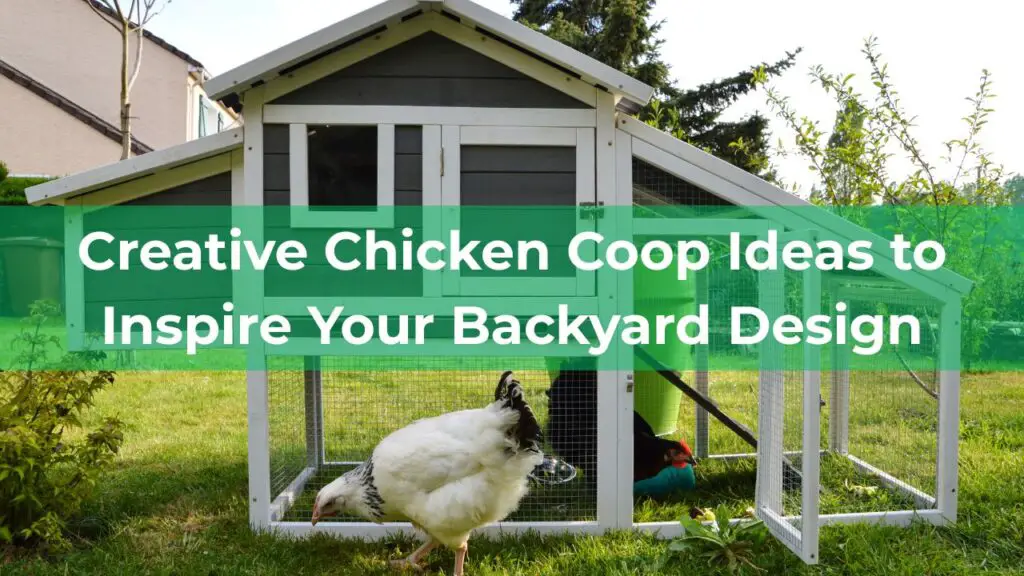Raised flower beds are a fantastic way to elevate your gardening game, making it easier to grow a variety of plants while adding a stylish touch to your outdoor space. These raised structures not only improve drainage and soil quality but also help to keep pests at bay. Plus, they provide a perfect solution for those with limited mobility who still want to enjoy the joys of gardening!
Choosing the Right Materials
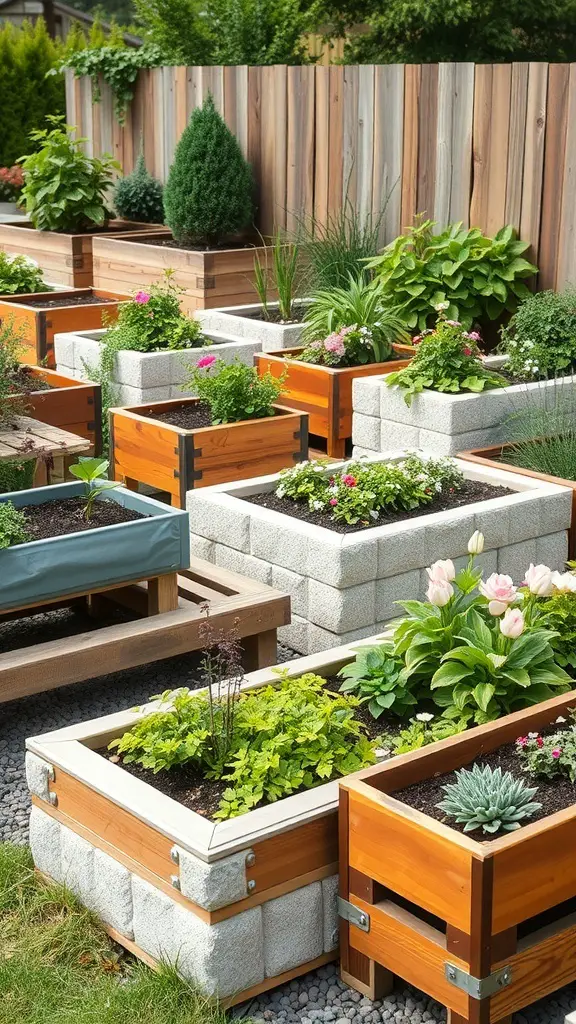
When it comes to raised flower beds, the materials you choose can make a big difference. The image shows a lovely arrangement of raised beds made from wood and concrete blocks. Each material has its own benefits.
Wood is a popular choice for its natural look. It blends well with gardens and can be treated to resist rot. On the other hand, concrete blocks offer durability and a modern aesthetic. They can withstand the elements and won’t warp over time.
Consider the plants you want to grow. Some materials retain heat better, which can be great for certain flowers. Others might drain water differently, affecting plant health. Think about how each material will impact your garden.
Also, don’t forget about maintenance. Wooden beds may require more upkeep, while concrete can be easier to clean. Choose what fits your lifestyle best. With the right materials, your raised flower beds can thrive beautifully!
Design Ideas for Aesthetic Appeal
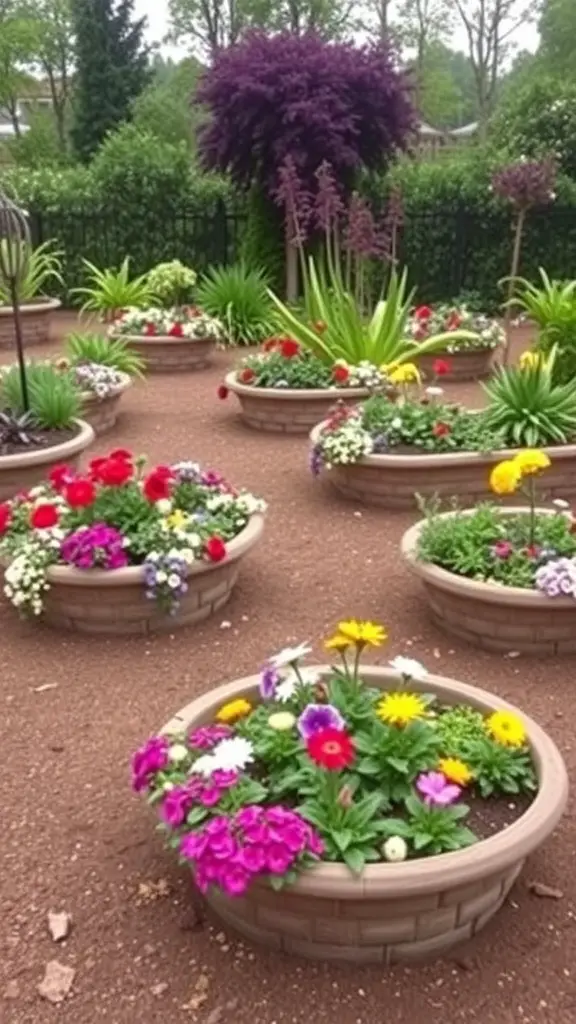
Raised flower beds can add a unique charm to any garden. The image showcases a vibrant arrangement of circular flower beds filled with colorful blooms. Each bed is carefully designed, creating a lovely visual rhythm across the space.
Consider using a mix of flowers in various colors and heights. This not only enhances the visual appeal but also attracts pollinators. The combination of bright reds, yellows, and purples in the image brings life to the garden.
Incorporating different shapes and sizes of flower beds can create interest. The circular beds in the image are a great example of how varying shapes can break the monotony of traditional rectangular designs. You might also think about adding some greenery around the beds for contrast.
Adding decorative elements like garden stakes or small sculptures can further enhance the aesthetic. These little touches can make your raised flower beds stand out even more. The overall layout in the image shows how thoughtful design can transform a simple garden into a stunning visual experience.
Benefits of Raised Flower Beds
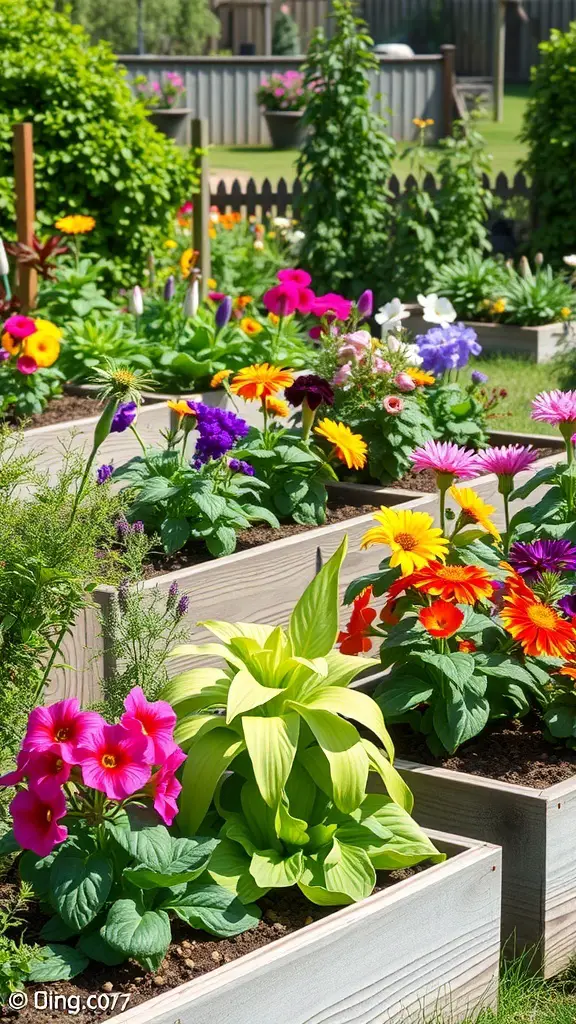
Raised flower beds are a fantastic way to enhance your gardening experience. They offer a neat and organized look, making your garden visually appealing. The image shows vibrant flowers in well-structured beds, showcasing the beauty and variety you can achieve.
One major benefit is improved drainage. Raised beds allow excess water to flow away easily, preventing root rot. This is especially helpful in areas with heavy rainfall. The soil in these beds warms up faster in spring, giving your plants a head start.
Another advantage is easier access. You can tend to your flowers without bending down too much, which is great for those with mobility issues. This setup also keeps pests away from your plants, making it easier to maintain a healthy garden.
Raised beds can also improve soil quality. You have control over the soil mix, allowing you to create the perfect environment for your flowers. This means healthier plants and more vibrant blooms.
Lastly, they can extend your growing season. With raised beds, you can plant earlier in the spring and enjoy blooms longer into the fall. This means more time to enjoy the beauty of your garden!
Best Flowers for Raised Beds
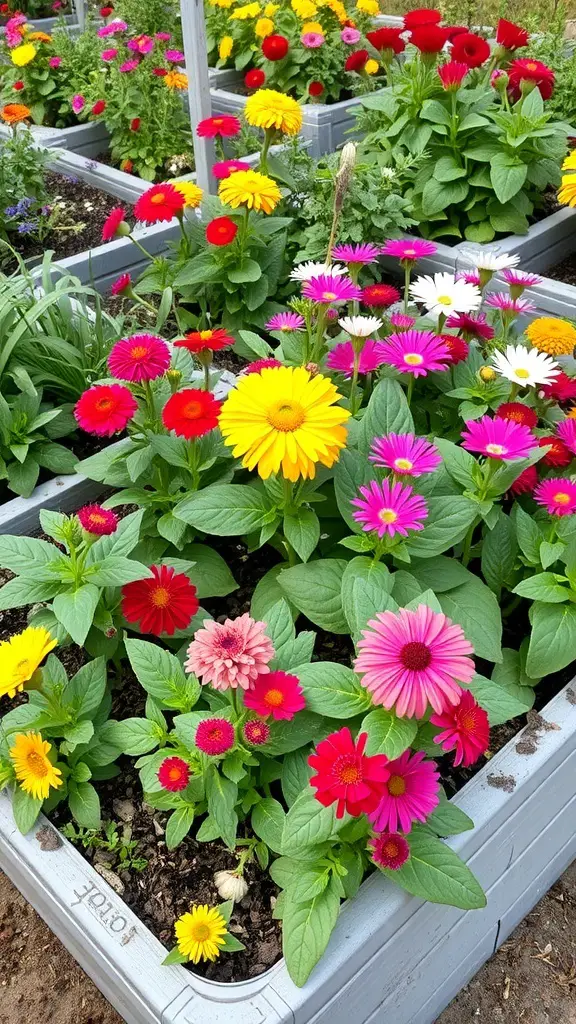
Raised flower beds are a fantastic way to grow vibrant blooms while keeping your gardening efforts organized. The image shows a colorful array of flowers thriving in a raised bed, showcasing the beauty and variety you can achieve.
When choosing flowers for raised beds, consider those that thrive in your local climate. Bright blooms like gerbera daisies and zinnias add a cheerful touch. Their bold colors can create a stunning visual display.
Mixing different types of flowers can enhance the overall look. For instance, pairing tall sunflowers with shorter marigolds can create depth and interest. This combination not only looks great but also attracts beneficial pollinators.
Don’t forget about maintenance! Flowers like petunias and cosmos are relatively low-maintenance, making them perfect for busy gardeners. They provide color without requiring too much attention.
Overall, the key is to choose flowers that you love and that will flourish in your raised beds. Happy planting!
Pest Management Strategies
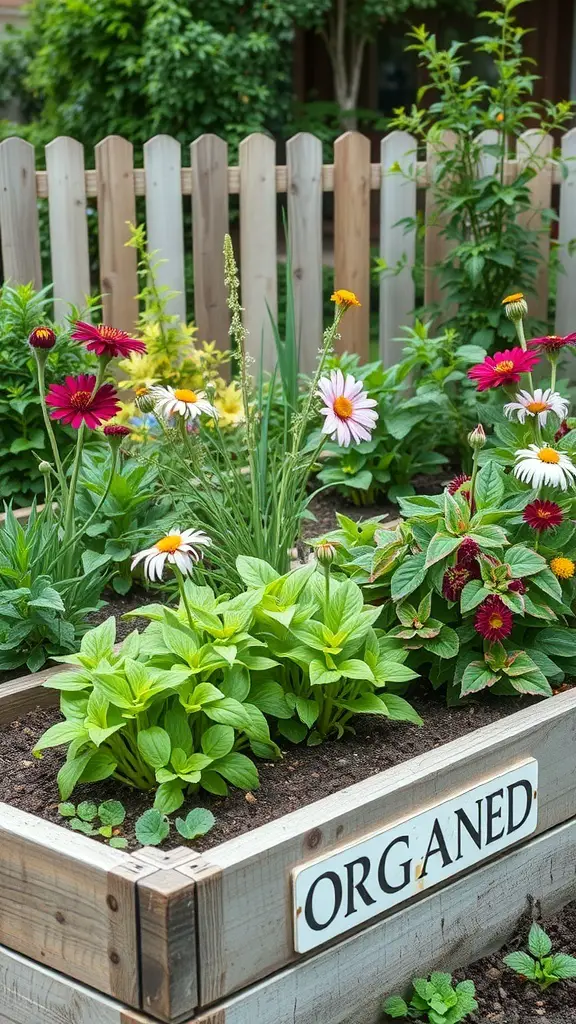
Raised flower beds are not just visually appealing; they also offer a practical way to manage pests. The elevation helps keep some pests at bay, making it easier to maintain healthy plants. In the image, you can see vibrant flowers and lush greenery thriving in a well-organized raised bed.
One effective strategy is to use companion planting. Certain plants can naturally repel pests or attract beneficial insects. For example, marigolds are known to deter nematodes and other harmful insects. Mixing these with your flowers can create a balanced ecosystem.
Another method is to use physical barriers. Floating row covers can protect young plants from insects while allowing sunlight and moisture to reach them. This simple addition can make a big difference in keeping your flowers safe.
Regular monitoring is key. Check your plants frequently for signs of pests. Early detection can prevent a small issue from becoming a larger problem. If you spot any unwanted visitors, consider using organic insecticides or homemade remedies to address the issue without harming beneficial insects.
Lastly, maintaining healthy soil is essential. Healthy plants are less susceptible to pests. Adding compost and organic matter can improve soil quality, leading to stronger plants that can better withstand pest pressures.
Seasonal Planting Tips
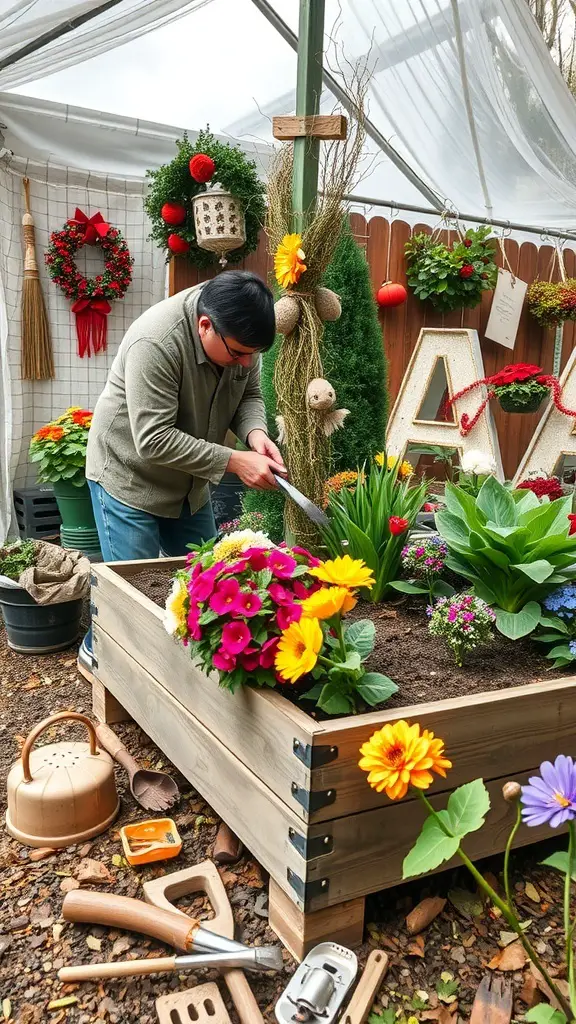
Raised flower beds are a fantastic way to bring color and life to your garden. They provide excellent drainage and can be easier to manage than traditional garden plots. In the image, we see someone tending to a vibrant flower bed filled with various blooms. The bright colors of the flowers pop against the wooden structure, creating a cheerful scene.
When it comes to seasonal planting, timing is key. In spring, consider planting annuals like petunias and marigolds. These flowers thrive in warmer weather and will add a burst of color. As summer approaches, you can switch to heat-tolerant varieties like zinnias and sunflowers.
In the fall, think about planting perennials such as asters and chrysanthemums. These plants will not only survive the cooler temperatures but will also come back year after year. Make sure to prepare your soil well by adding compost or organic matter to keep your plants healthy.
Don’t forget about winter! While many plants go dormant, you can still enjoy your raised beds by adding evergreen plants or winter decorations. This keeps your garden looking lively even in the cold months. With a little planning, your raised flower beds can be a year-round delight!
Optimal Soil Mix for Flowers
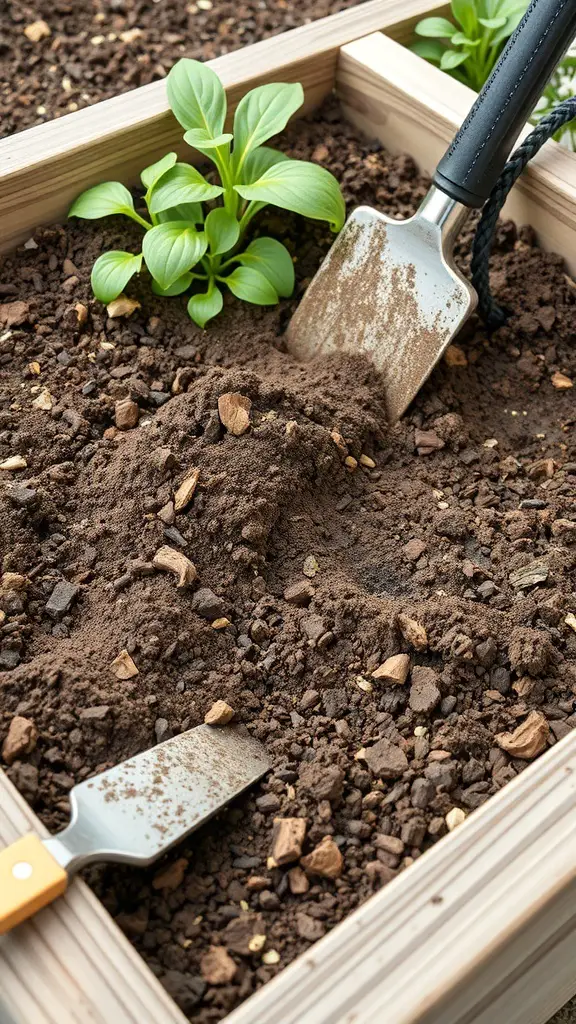
Creating a beautiful raised flower bed starts with the right soil mix. The image shows a well-prepared flower bed with rich, dark soil and a young plant peeking through. This setup is perfect for nurturing flowers, ensuring they have the nutrients they need to thrive.
The ideal soil mix typically includes a combination of compost, peat moss, and perlite or vermiculite. Compost adds essential nutrients, while peat moss helps retain moisture. Perlite or vermiculite improves drainage, preventing water from pooling around the roots.
When filling your raised bed, aim for a depth of at least 12 inches. This allows roots to grow deep and access nutrients. Mixing in some organic matter, like shredded leaves or aged manure, can also boost your soil’s fertility.
Don’t forget to check the pH level of your soil. Most flowers prefer a slightly acidic to neutral pH, around 6.0 to 7.0. You can adjust the pH with lime or sulfur if needed.
With the right soil mix, your flowers will not only grow but flourish, bringing color and life to your garden.
Watering Techniques for Raised Beds
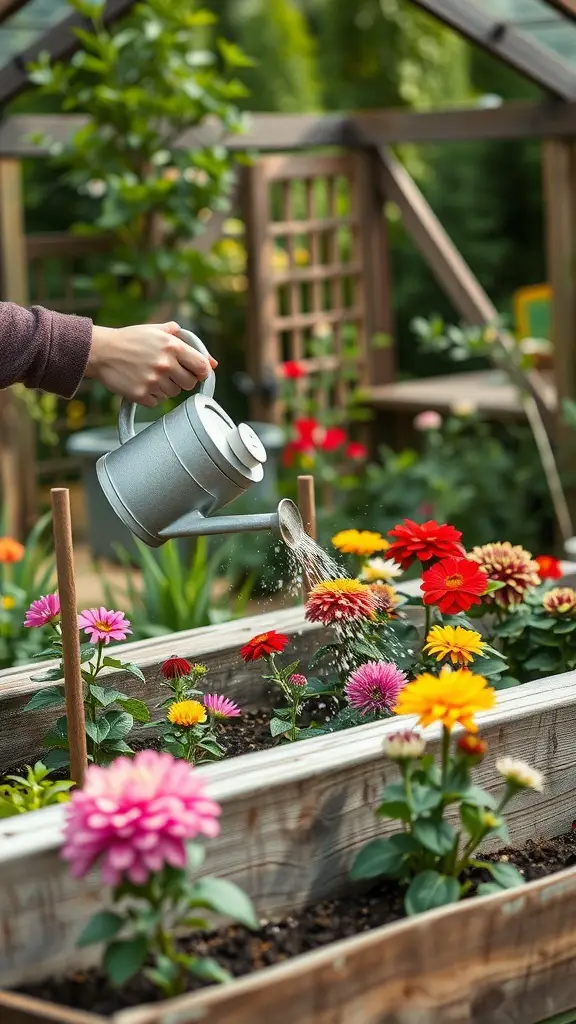
Watering raised flower beds can be a simple yet vital task. The image shows someone watering vibrant flowers in a wooden raised bed. A watering can is being used, which is a great tool for this purpose.
Using a watering can allows for precise control over how much water each plant receives. This is especially helpful in raised beds where plants may have different water needs. It’s important to water at the base of the plants to avoid wetting the leaves, which can lead to diseases.
Another effective method is drip irrigation. This system delivers water directly to the roots, minimizing waste and ensuring that plants get the moisture they need. It’s a great option for those who want to save time and effort.
Timing is also key. Watering early in the morning or late in the afternoon helps reduce evaporation. This way, your plants can soak up the water before the sun gets too hot.
Lastly, always check the soil moisture before watering. Stick your finger into the soil; if it feels dry an inch down, it’s time to water. This simple check can help prevent overwatering, which can harm your plants.
Seasonal Color Schemes for Flower Beds
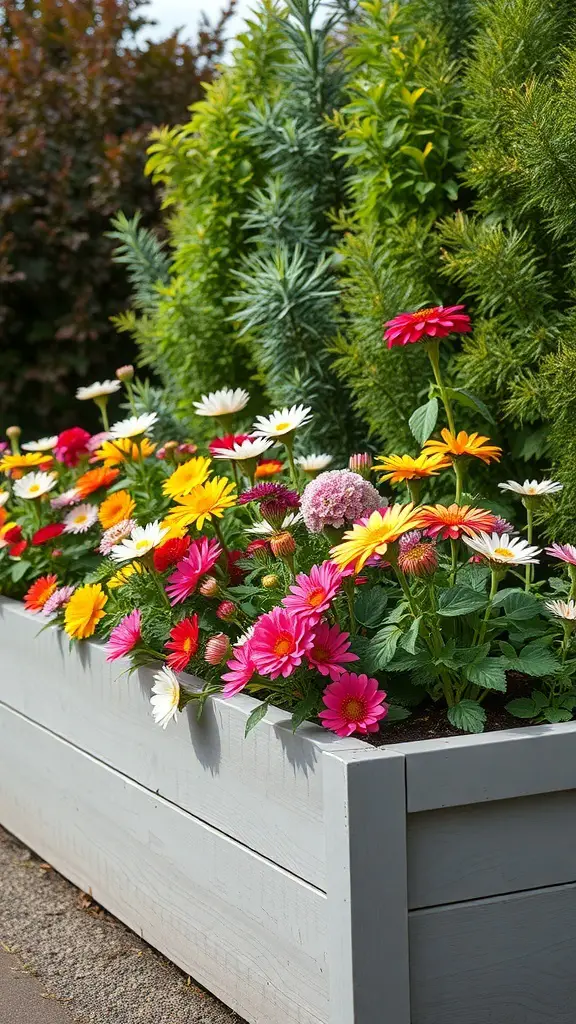
Raised flower beds are a fantastic way to showcase seasonal blooms. The image shows a vibrant mix of flowers in a neatly constructed planter. Bright yellows, pinks, and whites create a cheerful display that can brighten any outdoor space.
Choosing the right color scheme for your flower beds can make a big difference. In spring, consider pastel colors like soft pinks and light blues. These shades reflect the freshness of the season. Summer calls for bold and bright colors, just like the flowers in the image. Think sunny yellows and deep reds that pop against the greenery.
In fall, warm tones like oranges and browns can create a cozy atmosphere. Finally, winter can be a bit trickier, but evergreens and winter blooms can add life to your garden. Mixing textures and heights, as shown in the image, adds depth and interest to your flower beds.
Maintenance and Care for Raised Beds
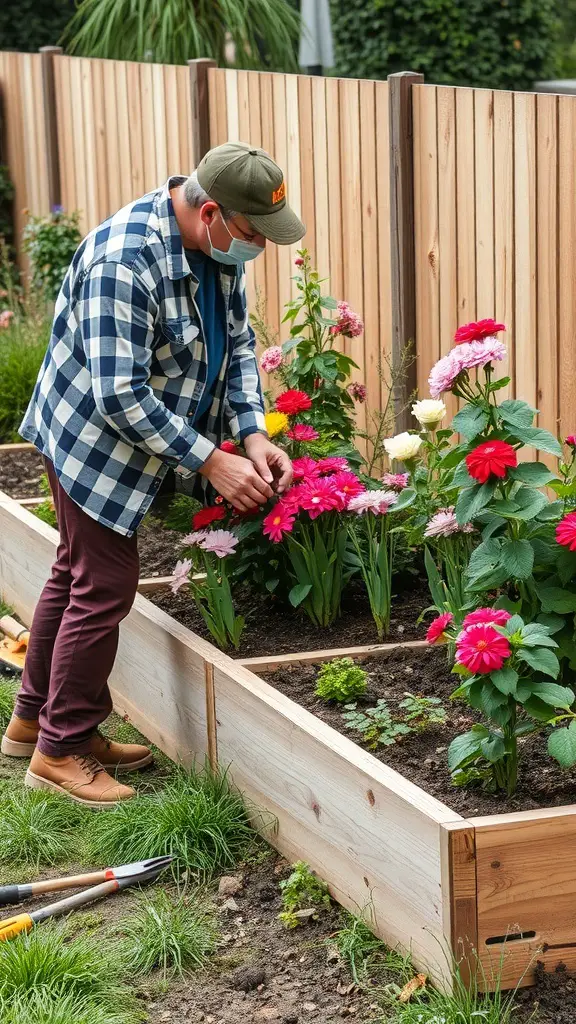
Raised flower beds are a great way to add beauty to your garden while making maintenance easier. In the image, a person is tending to vibrant flowers in a well-structured raised bed. This setup not only looks appealing but also allows for better soil drainage and easier access for planting and weeding.
To keep your raised beds thriving, regular care is key. Start by checking the soil moisture. Raised beds can dry out faster than traditional gardens, so watering is essential, especially during hot days. Adding mulch can help retain moisture and suppress weeds.
Next, keep an eye on the plants. Pruning dead flowers encourages new growth and keeps your garden looking tidy. It’s also a good idea to rotate your crops each season. This practice helps prevent soil depletion and reduces pest issues.
Lastly, don’t forget about fertilizing. Using organic compost or a balanced fertilizer can give your flowers the nutrients they need to flourish. With a little effort, your raised flower beds can become a stunning focal point in your outdoor space.
Integrating Edible Plants with Flowers
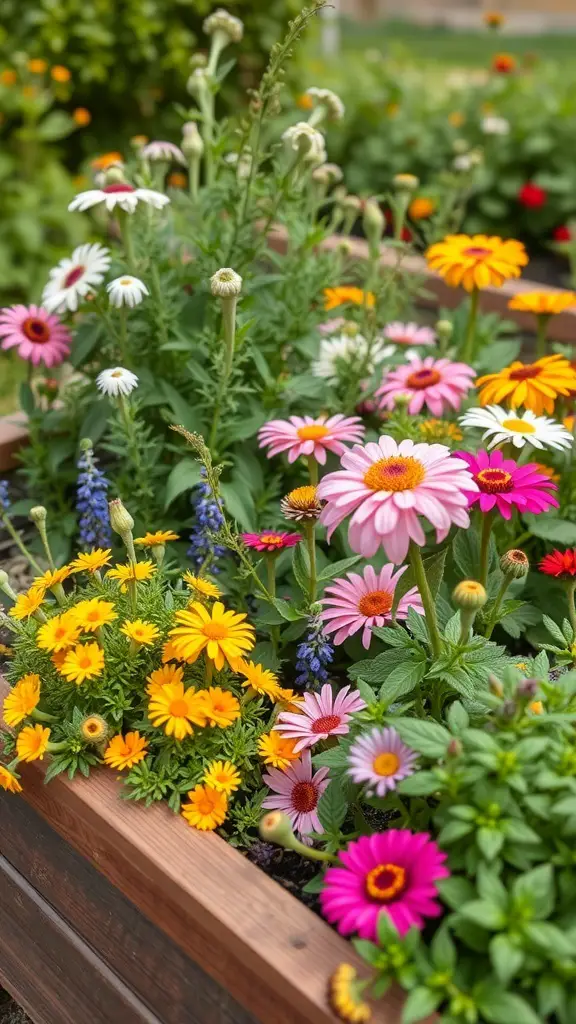
Raised flower beds can be a beautiful addition to any garden. They not only add color but also provide a great opportunity to grow edible plants alongside flowers. Imagine vibrant blooms like daisies and zinnias sharing space with herbs and vegetables.
Mixing edible plants with flowers creates a lively and functional garden. For instance, you can plant basil next to bright marigolds. This not only looks appealing but also helps repel pests. The flowers attract pollinators, which can improve the yield of your edible plants.
Consider using flowers like nasturtiums, which are edible and have a peppery flavor. They can add a unique twist to salads while enhancing the beauty of your raised beds. Plus, their bright colors can make your garden pop!
When planning your raised flower beds, think about the height and spread of each plant. Taller flowers can provide shade for smaller herbs, creating a diverse environment. This approach not only maximizes space but also encourages a thriving ecosystem.
Vertical Gardening in Raised Beds
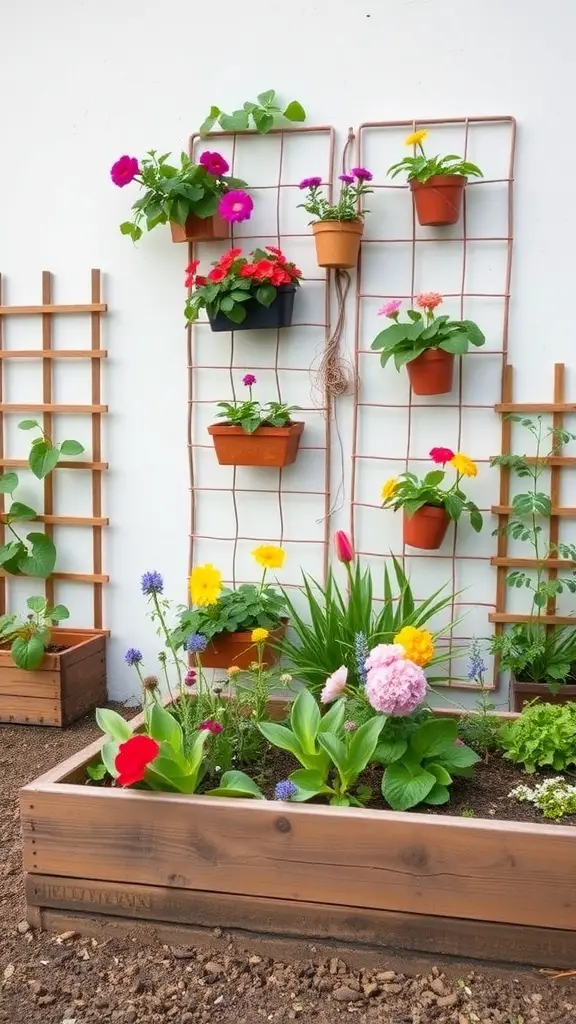
Vertical gardening is a fantastic way to maximize space, especially in raised beds. The image shows a vibrant setup where flowers are arranged on trellises, creating a beautiful vertical display. This method not only adds visual interest but also allows for better air circulation and sunlight exposure for the plants.
In the raised beds below, a variety of flowers bloom, showcasing the benefits of combining vertical and horizontal gardening. The colorful pots hanging on the trellis complement the lush greenery in the beds, making the garden feel lively and inviting.
Using vertical space helps gardeners grow more in smaller areas. It’s perfect for urban settings where ground space is limited. Plus, it makes maintenance easier, as you can reach plants without bending down too much.
Incorporating vertical elements like trellises or wall planters can transform your garden into a stunning focal point. Whether you choose flowering plants or even herbs, the possibilities are endless. So, grab some pots and get creative with your raised beds!
Creating a Pollinator-Friendly Environment
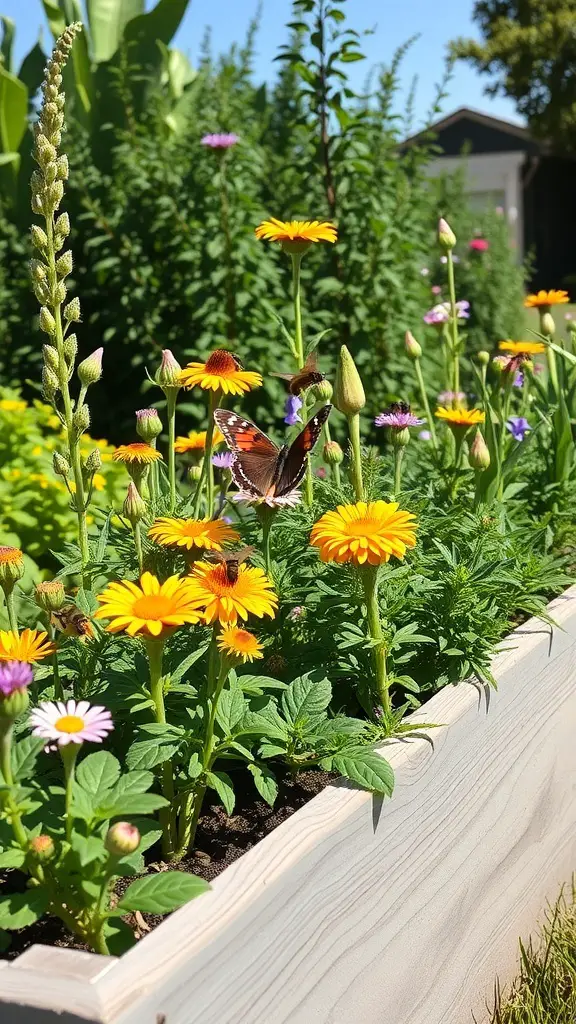
Raised flower beds are a fantastic way to create a vibrant space for pollinators. The image shows a colorful array of flowers, with butterflies and bees happily buzzing around. This lively scene highlights the importance of selecting the right plants to attract these essential creatures.
When planning your raised flower beds, consider including a mix of native flowers. These plants are often more appealing to local pollinators. Bright colors and varied shapes can draw in butterflies and bees, making your garden a lively spot for them to visit.
Incorporating flowers that bloom at different times ensures that there’s always something in bloom. This continuous supply of nectar helps support pollinators throughout the growing season. Plus, the raised beds make it easier to tend to your plants, keeping them healthy and thriving.
Creating a pollinator-friendly environment not only benefits the insects but also enhances your garden’s beauty. Watching butterflies flutter and bees buzz around adds a joyful element to your outdoor space. So, grab your gardening tools and start planting!
Innovative Irrigation Solutions
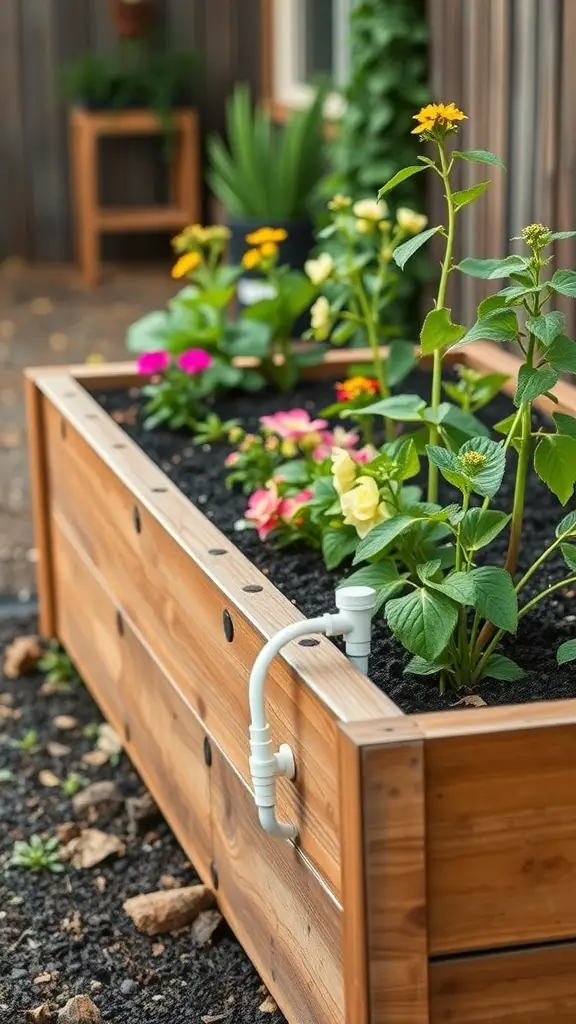
Raised flower beds are a fantastic way to showcase your gardening skills. They not only look great but also offer practical benefits. One of the key features in modern raised beds is the irrigation system, which helps keep your plants healthy and thriving.
The image shows a beautifully constructed raised flower bed filled with vibrant flowers. Notice the irrigation setup on the side? This is a smart addition that ensures your plants receive consistent moisture without the hassle of manual watering.
Using an irrigation system can save time and water. It allows you to focus on enjoying your garden rather than worrying about watering schedules. With a simple setup, you can ensure that each plant gets the right amount of water it needs.
Whether you’re growing flowers or vegetables, innovative irrigation solutions can make a big difference. They help maintain the perfect environment for your plants, leading to a more fruitful and colorful garden.
DIY Raised Bed Construction
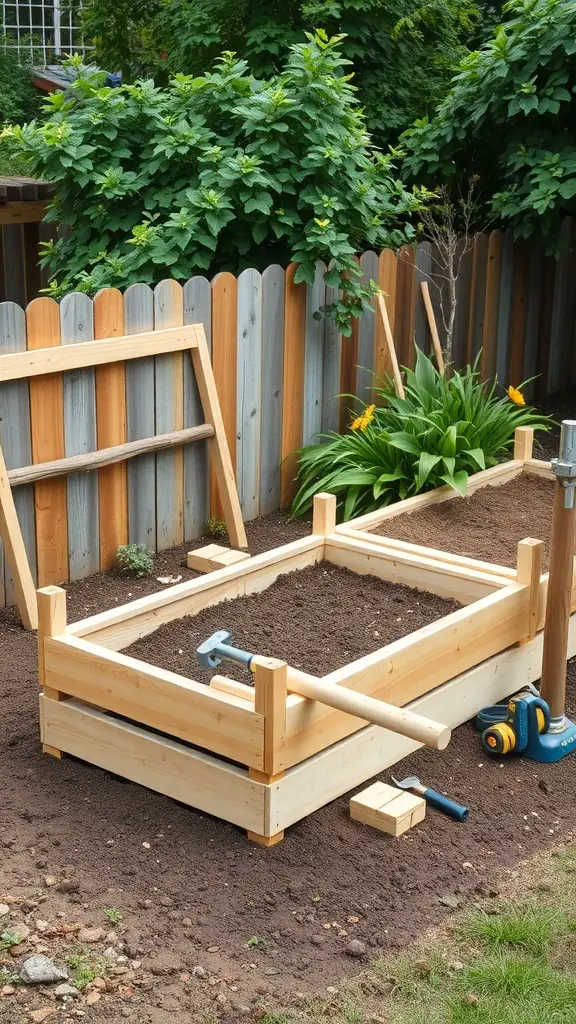
Building your own raised flower beds can be a fun and rewarding project. The image shows a neatly constructed raised bed, ready for planting. The wooden frame is sturdy and well-assembled, providing a perfect space for flowers or vegetables.
To start, gather your materials. You’ll need untreated wood, screws, and soil. Choose a location that gets plenty of sunlight. The raised bed in the image is positioned well, surrounded by greenery and a wooden fence that adds charm.
Next, cut the wood to your desired dimensions. Assemble the frame by securing the corners with screws. The height of the bed can vary, but a common height is about 12 to 18 inches. This makes it easier to tend to your plants without bending over too much.
Once the frame is ready, fill it with a mix of soil and compost. This will help your plants thrive. The image shows the bed filled with rich, dark soil, indicating it’s ready for planting. Don’t forget to water your plants regularly, especially in the early stages.
Raised beds not only improve drainage but also keep pests at bay. Plus, they can be a beautiful addition to your garden. So grab your tools and get started on your DIY raised bed!

